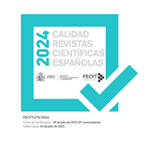Indicadores semánticos para el estudio del humor en la comunicación: el caso de la fraseología en los monólogos
Resumen
Este trabajo tiene como objetivo estudiar los indicadores lingüísticos fraseológicos en un género humorístico concreto, los monológos. Para estudiar el humor verbal en diferentes enunciados, nos basamos en los análisis realizados por el grupo GRIALE y Ruiz Gurillo (2012), y en la Teoría General del Humor Verbal, propuesta por Attardo (2001), que afirma que en el texto humorístico debe haber una serie de mecanismos lingüísticos en el enunciado que ayudan al interlocutor a la correcta interpretación del mismo (Alvarado 2006, 2010). Así pues, en un género propiamente humorístico como es el monólogo es fundamental observar dónde aparecen los indicadores lingüísticos y cuáles son las pistas que deja el monologuista para que el oyente interprete el enunciado de modo humorístico (Ruiz Gurillo 2012, 2013): Nos centramos en la fraseología, ya que es un recurso rentable para generar humor, debido a los rasgos intrínsecos que posee.
Descargas
Descarga artículo
Licencia
La revista Círculo de Lingüística Aplicada a la Comunicación, para fomentar el intercambio global del conocimiento, facilita el acceso sin restricciones a sus contenidos desde el momento de su publicación en la presente edición electrónica, y por eso es una revista de acceso abierto. Los originales publicados en esta revista son propiedad de la Universidad Complutense de Madrid y es obligatorio citar su procedencia en cualquier reproducción total o parcial. Todos los contenidos se distribuyen bajo una licencia de uso y distribución Creative Commons Reconocimiento 4.0 (CC BY 4.0). Esta circunstancia ha de hacerse constar expresamente de esta forma cuando sea necesario. Puede consultar la versión informativa y el texto legal de la licencia.











